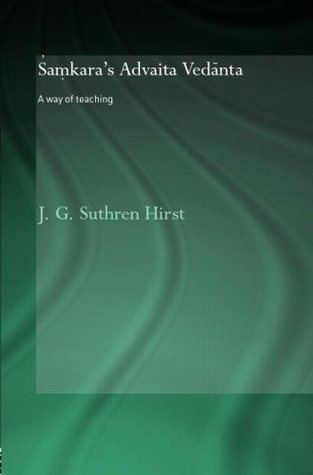Kindle Notes & Highlights
Read between
October 28 - December 22, 2019
We can only emphasize the two points we have just made: (i) action, for , involves option, knowledge does not; (ii) knowledge of brahman is not knowledge of an object but the state in which all objectivizing superimpositions have been removed.
Discrimination between eternal and non-eternal matters (ii) Dispassion towards the enjoyment of the results (of actions) here and hereafter (iii) Accomplishment of practices such as mental tranquillity and control of the senses (iv) Desiring liberation.
recognize its limitations before becoming eligible.
According to Thousand Teachings, Prose Chapter 1, the pupil should also be a wandering ascetic, a pure brahmin, should approach his teacher in the proper way, and should have been scrutinized with respect to his caste, occupation (or ritual action), conduct, knowledge (of the Veda), and family.
This is probably because the more fundamental requirement is that the pupil should be a ascetic. In medieval times, this was the highest of four grades of renouncers. is not yet aware of this later categorization, but the term already connotes a renouncer of the purest kind.
Prose Chapter 2, however, only requires the pupil to be a brahmacārin, not a fully fledged renouncer.
His key point is that the word ‘brahma’ here refers to the supreme reality (not to the brahmin ) and that this brahman is the whole focus of Vedānta, not just a subsidiary part of it. Brahman, as supreme reality, is unequivocally identified as the subject-matter of the Brahmasūtras, the , which they summarize and the system of (Advaita) Vedānta that pursues the enquiry in hand.
will be concerned to explore in more detail what the nature of brahman might
Brahman is thus indicated to be first and final cause,
however, that the correct source of this idea is not human reasoning about the world in which we live, but the testimony of scripture.
he justifies, as we have already seen, by the fact that ‘the awareness of brahman is the purpose (artha) of human beings because it destroys the worthless (anartha-) misconception, etc. which is the seed of the whole world of rebirth’ (p.
Through knowledge of brahman, a human being’s highest purpose is achieved.
The first is an etymology. Brahman, says , is by nature eternally pure, realized and free, omniscient, possessing omnipotence. Now the word ‘brahman’ comes from a root , meaning ‘to be great’.
namely, liberation. ‘Brahman’ is the source of everything, known from scripture, from the meaning of the word itself and, initially, from our own, though often mistaken, sense of identity. The ‘desire to know’ leads to the ‘enquiry’ that is needed to sort out the correct interpretation of self from misdeductions and wrong views of scriptural teaching.
‘person fit for study’, the adhikārin, has been described above.
Finally, the ‘purpose’ is
At the other extreme, the 2 held that there was a set of six s that were not reducible to one another (which is not to say that there are not some relations of dependence between them). These were: direct sense perception (pratyakśa); inductive inference (anumāna); verbal testimony (śabda); comparison (upamāna); presumption (arthāpatti); and non-cognition (anupalabdhi). tends to focus on the first three and it is on these that we shall concentrate in investigating his claim that śabda is the only for brahman. All schools, apart from the Madhyamaka, but including the Materialists, accepted
...more
It is for this reason that he holds that brahman is beyond sense perception.
This is because brahman is not an object to be cognized, but the very cognizer of all cognitions.
accepts anumāna as a source of knowledge about the world, but he points out how susceptible it is to problems.
Where brahman is concerned, anumāna is automatically ruled out.
therefore criticizes the Naiyāyikas and others who sought to establish the existence
The third identified by the s was verbal testimony (śabda).
First, then, the s and Vedāntins argued that scripture is needed as a for those matters that are beyond the scope of sense perception, which are transcendental issues.
Second, the reliability of the śruti texts is underpinned in and Vedānta with the doctrine of
Third, the texts are seen to be fruitful in Vedānta because they actually do liberate people.
does, however, take seriously the viewthat each , including scriptural testimony, has its own sphere.
For and the Ritualists, a word first of all refers to its , a kind of concrete universal or generic configuration, of which particular objects
denoted by the eternal Vedic word, remains permanent.
Since they are reliable in this respect (that is, in relation to dharma), there is no reason to doubt their validity in relation to knowledge of brahman –
Our final clue is ’s actual use of the term ‘ ’ in a revealing passage in the
Even so, holds, we can talk about scripture wanting to express something in a metaphorical sense.
First of all, it is quite difficult to explain the metaphor of what is ‘desired to be expressed’ in any way that does not itself suggest precisely that personal intention which cannot be ascribed to the texts.
It is corrected and complemented by another image, brahman ‘breathing out’ the Vedic texts
But breathing is not just intimate, it is done (usually) without thought or effort.
that the Veda issues without effort, comments, indicates that it is a , not like other books.
He seems to mean that other books require the effort of composition, wh...
This highlight has been truncated due to consecutive passage length restrictions.
brahman as the source of scripture (BSBh 1.1.3).
’s most important principle is that of non-duality.
‘The knower of brahman attains the highest’.
subtly exploits the double meaning of the compound


